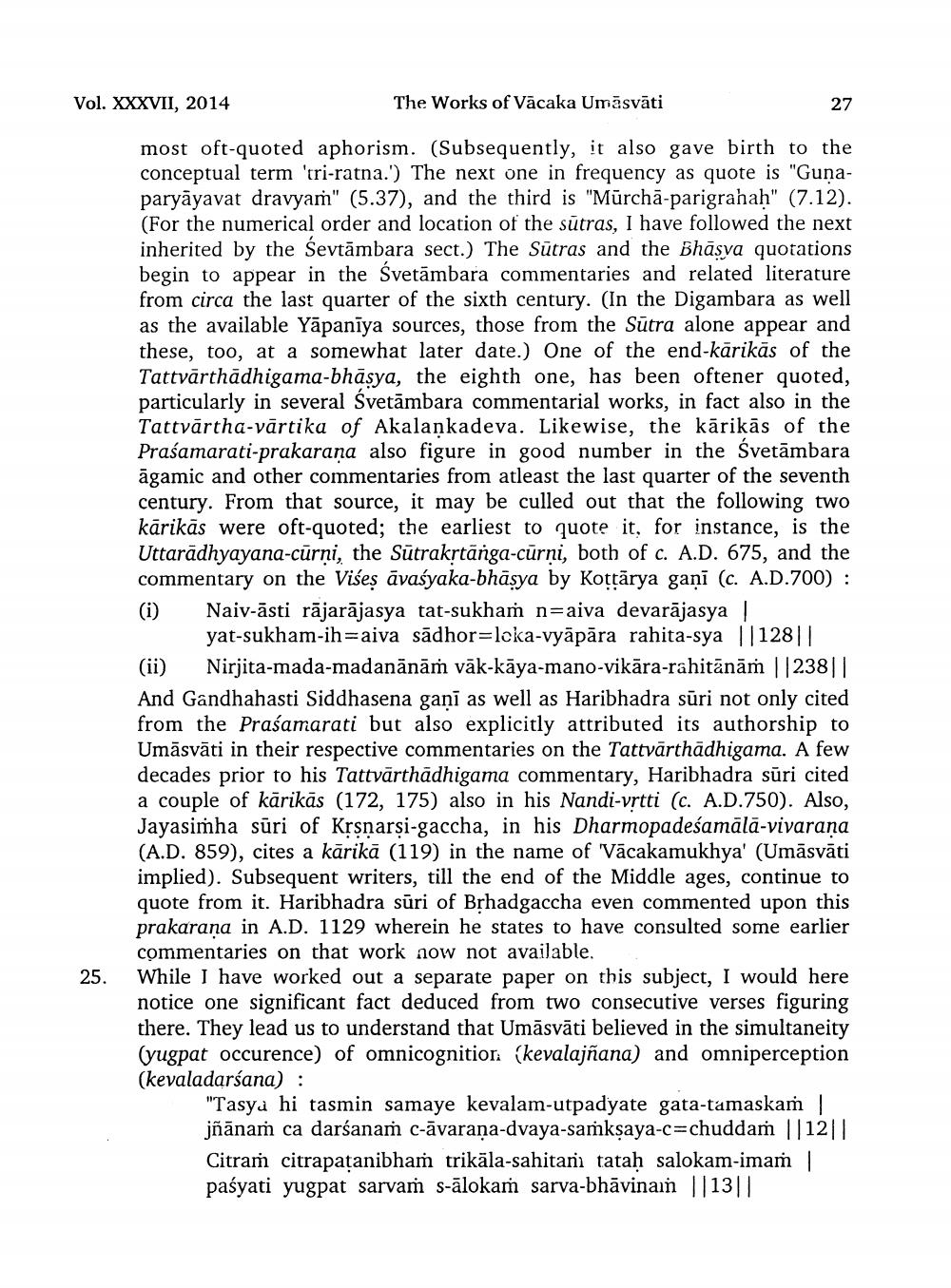________________
Vol. XXXVII, 2014
The Works of Vācaka Umāsvāti
27
most oft-quoted aphorism. (Subsequently, it also gave birth to the conceptual term 'tri-ratna.') The next one in frequency as quote is "Gunaparyāyavat dravyam" (5.37), and the third is "Mūrchā-parigrahah" (7.12). (For the numerical order and location of the sūtras, I have followed the next inherited by the Sevtāmbara sect.) The Sūtras and the Bhāsva quotations begin to appear in the Svetāmbara commentaries and related literature from circa the last quarter of the sixth century. (In the Digambara as well as the available Yāpanīya sources, those from the Sūtra alone appear and these, too, at a somewhat later date.) One of the end-kārikās of the Tattvārthādhigama-bhāsya, the eighth one, has been oftener quoted, particularly in several Svetāmbara commentarial works, in fact also in the Tattvārtha-vārtika of Akalankadeva. Likewise, the kārikās of the Praśamarati-prakarana also figure in good number in the Svetāmbara āgamic and other commentaries from atleast the last quarter of the seventh century. From that source, it may be culled out that the following two kārikās were oft-quoted; the earliest to quote it, for instance, is the Uttarādhyayana-cūrni, the Sūtrakrtānga-cūrni, both of c. A.D. 675, and the commentary on the Višes āvasyaka-bhāsya by Kottārya gani (c. A.D.700) : (i) Naiv-āsti rājarājasya tat-sukham n=aiva devarājasya
yat-sukham-ih=aiva sādhor=lcka-vyāpāra rahita-sya ||128|| (ii) Nirjita-mada-madanānām vāk-kāya-mano-vikāra-rahitānām ||238||| And Gandhahasti Siddhasena gani as well as Haribhadra sūri not only cited from the Praśamarati but also explicitly attributed its authorship to Umāsvāti in their respective commentaries on the Tattvārthādhigama. A few decades prior to his Tattvārthādhigama commentary, Haribhadra sūri cited a couple of kārikās (172, 175) also in his Nandi-vrtti (c. A.D.750). Also, Jayasimha sūri of Krsnarsi-gaccha, in his Dharmopadeśamālā-vivarana (A.D. 859), cites a kārikā (119) in the name of "Vācakamukhya' (Umāsvāti implied). Subsequent writers, till the end of the Middle ages, continue to quote from it. Haribhadra sūri of Brhadgaccha even commented upon this prakarana in A.D. 1129 wherein he states to have consulted some earlier commentaries on that work now not available. While I have worked out a separate paper on this subject, I would here notice one significant fact deduced from two consecutive verses figuring there. They lead us to understand that Umāsvāti believed in the simultaneity (yugpat occurence) of omnicognitiori (kevalajñana) and omniperception (kevaladarśana):
"Tasya hi tasmin samaye kevalam-utpadyate gata-tamaskam jñānam ca darśanaṁ c-āvarana-dvaya-samkşaya-c=chuddaṁ ||12|| Citram citrapatanibham trikāla-sahitani tatah salokam-imam paśyati yugpat sarvam s-ālokam sarva-bhāvinain ||13||
25.




